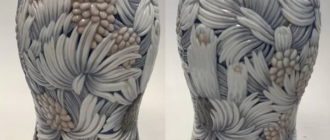
The work of the English potter George Owen (1845-1917), who perfected the production of products with mesh walls at the Royal Worcester Manufactory, is surprising and admirable. His almost jeweler’s work on the creation of thin-walled openwork vessels was very popular among buyers. His methods were considered trade secrets, and Owen himself maintained the utmost confidentiality in his work.
Beginning his career in June 1859 at the age of 13, George Owen first worked as a “porcelain presser” in the ornamental department, where he was assigned to cut holes using a molded outline in porcelain pieces imitating Sèvres products. Owen’s passion for carved porcelain, which became his life’s work, prompted him to begin work on improving the technology of reticulated porcelain produced by Royal Worcester. He managed to master the creation of mesh vessels with double walls. Such items were extremely expensive due to the high risk of damage from repeated firing.
Although other craftsmen created netted china before George Owen, none of them reached such a high quality in their work. Owen carefully guarded the secrets of his craft, working with tools of his own making and putting them away on the table if someone entered his workshop. Using compasses and calipers, Owen carefully measured the circumference of the vessel, marking the places of the incisions. Then I carefully pulled out the part after cutting out the outline. Work on large vases could take several months, often the product was returned to the “wet box” so that the clay did not dry out. Owen’s endless patience, meticulousness, and craftsmanship have perfected this essentially ancient technology to unrivaled perfection.
Products by George Owen































